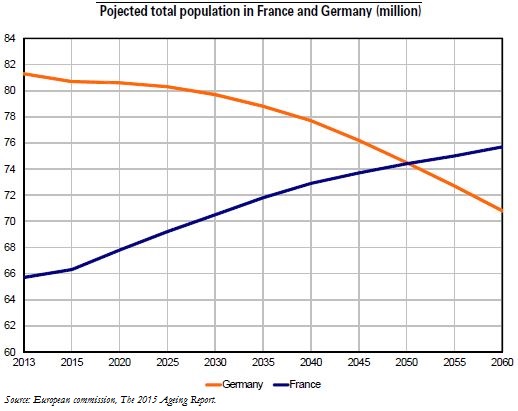Trésor-Economics No. 149 - Will demography disrupt the German economic model?
Germany's population decline has already begun, despite the short-term stabilisation provided by immigration. In 2013, Germany's total population of 81.3 million had already fallen by 500,000 since 2003. In very recent years, it has been stabilised by a strong wave of immigration, but whether that pattern will persist remains uncertain, as shown by alternating periods of positive and negative net flows in the past. Since 2008, Germany has again become a host country for immigrants. Despite increased flows from the southern part of the euro area due to the economic crisis, the main sources of inflows have been the Eastern European countries. Future annual net inflows of immigrants are projected to vary between 100,000 and 250,000, with differences depending on the time horizon and assumptions. In any event, however, those levels will be too low to stop Germany's population from shrinking.
Over the long term, Germany's population decline should accelerate, with the total population set to be less than that of France as from 2050. The trend should intensify and Germany's population should continue to age owing to rising life expectancy at birth and low fertility. The total population is projected to contract by 13.5% between now and 2060, according to the European Commission. The working-age population is expected to shrink to an even greater extent, by roughly 30%. By 2050, Germany's population should have fallen to 75 million, the same level as France where the population should continue to climb to 75.7 million compared with 65.7 million in 2013.
The simulations project a decline in the economically active population by 2060. The trend is expected to be quite pronounced in the period until 2035, before easing between 2035 and 2060. The German economy, already close to full employment, should experience a labour-force shortage, constraining the labour supply and therefore potential growth. International organisations see potential growth falling from 1.5% a year in 2015 to 0.7% around 2030, before rising to roughly 0.9% in 2050-2060.
Population ageing should entail higher social spending for pensions, health and long-term care, rising from 18% of GDP in 2010 to 25% in 2060. If government revenue as a percentage of GDP remains unchanged, that could lead to a severe worsening of the general government fiscal balance, and then public debt.
The authorities have taken action to deal with these issues, including efforts to raise the birth rate through a more generous family policy and broader access to day care for young children, easing of restrictions on the free movement of workers from Central and Eastern European countries, facilitating the immigration of skilled labour, and encouraging labour market participation by older people and women. The impact of these measures, however, remains uncertain.
